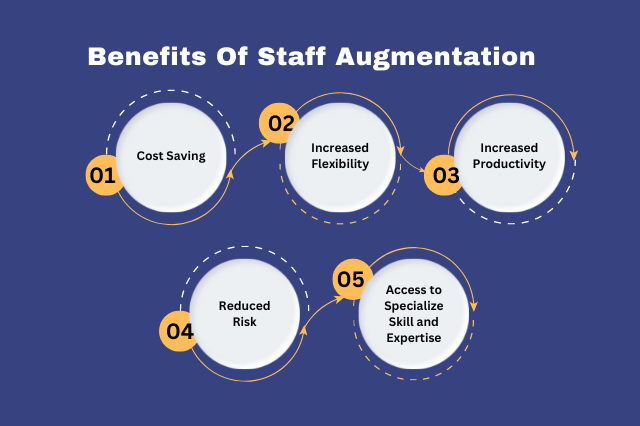Everything You Should Know About Staff Augmentation

Everything You Should Know About Staff Augmentation
Workload fluctuation is common in developing businesses. To achieve the deadline, you require more hands and minds. You could hire new workers if you are limited in resources. Staff augmentation proves to be the wisest course of action.
The staff augmentation approach still needs to be better understood by a lot of businesses. It is a strategy that many companies use to address staffing needs while maintaining flexibility and controlling costs.
Do you want to know more about it? So, read this blog and understand staff augmentation in more detail now so you can know what it is, its types, its benefits, etc., before utilizing it.
What is Staff Augmentation?
Staff augmentation is a business strategy where a company hires additional staff, usually on a temporary or contract basis, to supplement its workforce for specific projects or tasks.
The purpose of staff augmentation is to increase capacity, efficiency, and productivity without the expenses and commitment of hiring permanent employees. Depending on the company’s needs and work type, the additional staff can be located on-site or remotely.
It is commonly used in industries such as technology, healthcare, finance, and manufacturing, where there is a need for specialized skills and expertise for specific projects or tasks. It allows companies to manage their staffing needs more effectively and efficiently while maintaining flexibility and control over their workforce.
Types of Staff Augmentation
Companies can use several types of staff augmentation to supplement their existing workforce. Here are some common types of staff augmentation:
-
Contract Staffing
This type of staffing involves hiring a temporary employee for a specific period to complete a specific project or task. The contract employee may be employed directly by the company or a third-party staffing agency. This type of staff augmentation is ideal for short-term staffing needs.
-
Temporary Staffing
Temporary staffing involves hiring an employee for a limited period, usually to cover for an employee who is on leave, to fill a short-term staffing need, or to support a seasonal business cycle.
Temporary employees may work full-time or part-time, depending on the company’s needs. The staffing agency or the company is responsible for paying the employee’s salary, benefits, and other employment-related costs. It can be an efficient and cost-effective solution for companies needing additional staff for a short period or a specific project.
-
Project-Based Staffing
Project-based staffing involves hiring a team of temporary employees with specific skills and expertise needed to complete a specific project. The team may consist of project managers, engineers, designers, programmers, and other professionals with specialized skills required for the project.
This type of staff augmentation is ideal for large projects that require a specific skill set that the company’s existing workforce may not have. In addition, project-based staffing allows companies to quickly ramp up resources for a specific project without committing to long-term employment contracts.
-
Offshore Staffing
Offshore staffing involves hiring employees from different countries to work on specific projects. The team may work remotely or on-site, depending on the company’s needs and the nature of the work. Offshore staffing effectively allows companies to reduce costs and access specialized expertise that may not be available elsewhere.
This type of staffing can also give companies access to a larger pool of talent and a more diverse workforce. However, offshore staffing also comes with its own set of challenges, including language and cultural barriers, time zone differences, and legal and regulatory issues. Therefore, companies must carefully consider these factors before engaging in offshore staffing.
The types of staff augmentation a company uses will depend on their specific needs and the work to do. Therefore, companies should carefully consider the pros and cons of each type of staff augmentation before making a decision.
Read More: Top 10 Benefits of Hiring an Offshore Web Development Team
How Does Staff Augmentation Work?
Staff augmentation typically works by a company hiring temporary or contract employees through a staffing agency or an independent contractor to work on specific projects or tasks for a defined period.
Here are some steps of how staff augmentation works:

- Identifying the Need: The company identifies the need for additional staff to complete a project or task or to supplement its existing workforce to meet business demands.
- Defining Job Requirements: The company defines the job requirements, including the skills, experience, and qualifications necessary.
- Contacting Staffing Agency or Independent Contractor: The company contacts a staffing agency or an independent contractor to provide them with temporary or contract employees who meet the job requirements.
- Screening Candidates: The staffing agency or independent contractor screens candidates and provides the company with a list of qualified candidates to choose from.
- Interviewing Candidates: The company interviews candidates and selects the most qualified candidates to work on the project or task.
- Onboarding: The temporary or contract employees are onboarded and integrated into the company’s workforce.
- Managing and Supervising the Work: The company manages and supervises the work of the temporary or contract employees, ensuring they meet the project requirements and expectations.
- Payment and Compensation: The staffing agency or independent contractor pays the temporary or contract employees, and the company compensates the staffing agency or independent contractor for the services provided.
- Completion of the Project: Once the project or task is completed, the temporary or contract employees are released from their contract, and the company ends its engagement with the staffing agency or independent contractor.
Benefits of Staff Augmentation
There are several benefits of staff augmentation for companies, including:

-
Cost Saving
Staff augmentation can be a cost-effective alternative to hiring permanent employees, as companies can avoid the costs associated with recruiting, training, and retaining permanent employees.
In addition, companies can also avoid the costs of providing benefits, vacation time, and other perks typically associated with permanent employment. Staff augmentation allows companies to hire temporary or contract employees for a specific period or project and pay them only for their work hours or the project duration. This can help companies save on labor costs and reduce their overall expenses.
-
Increased Flexibility
One of the key benefits of staff augmentation is the increased flexibility it provides to companies. Staff augmentation allows companies to quickly adjust their staffing levels up or down depending on their changing needs, which can help them adapt to changing market conditions, project requirements, and business cycles.
For example, if a company needs additional resources to complete a project on time, it can quickly hire temporary employees through staff augmentation to meet the project deadline. Alternatively, if a company experiences a slowdown in business, it can quickly reduce its staffing levels to control costs. This flexibility allows companies to manage their resources more effectively and respond quickly to changing circumstances.
-
Increased Productivity
Staff augmentation can increase productivity by providing additional resources to quickly and efficiently complete projects or tasks. This can help companies achieve their goals and objectives faster and more effectively.
For example, a marketing company may need to launch a new advertising campaign but may need more staff to complete the project within the required timeline. Through staff augmentation, the company can hire additional staff to help with the campaign, increasing their productivity and ability to meet the project deadline.
-
Reduced Risk
Staff augmentation allows companies to mitigate this risk by hiring temporary or contract employees who can be let go once their services are no longer required. This can help companies avoid the legal and financial implications of terminating permanent employees and help them manage their labor costs more effectively.
It can also help companies avoid the risk of hiring permanent employees who may not have the necessary skills or experience to perform their duties effectively. By hiring temporary or contract employees through staff augmentation, companies can evaluate their performance before deciding whether to offer them a permanent position, reducing the risk of making a bad hire.
-
Access to Specialized Skills and Expertise
Staff augmentation allows companies to access specialized skills and expertise that may not be available in-house. This can help companies complete complex projects or tasks that require specific knowledge or experience.
For example, a software development company may need to develop a mobile app but may need to gain the necessary skills or experience in-house to complete the project. Through staff augmentation, the company can hire temporary or contract employees with expertise in mobile app development to complete the project.
This allows the company to access the skills and expertise they need to complete the project successfully without investing in training or hiring permanent employees with those skills.
When Should You Choose Staff Augmentation?
This approach is often used when a company needs to scale up quickly or needs more specific skills for a project. Here are some situations in which staff augmentation can be a good choice:
Temporary increase in workload: It can be a good option if your company has a temporary increase in workload that requires additional resources. This can happen during peak seasons or when a company lands a big project that requires more workforce.
Short-term projects: Staff augmentation is a good choice for short-term projects that require specific skills. Rather than hiring a full-time employee with those skills, staff augmentation can provide a more cost-effective solution.
Lack of specialized skills: If your company doesn’t have the specialized skills required for a project, staffing can provide those skills temporarily. This can be more efficient than training existing staff or hiring a full-time employee with those skills.
Time-sensitive projects: It can be good for projects that must be completed quickly. With staff augmentation, a company can quickly bring in additional resources to complete the job on time.
Final Thoughts
Staff augmentation is a flexible and cost-effective way for companies to supplement their existing workforce, access specialized skills and expertise, and increase productivity without the long-term commitment and costs of hiring permanent employees. It is a great option if you need to offload your internal team or start a side project.
Don’t hesitate to get in touch with Adrem Technologies at info@localhost so that we can help you hire the best staff for your project or company.

